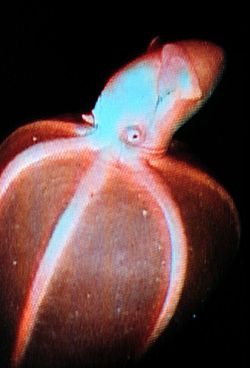| Stauroteuthis | |
|---|---|
 | |
| Stauroteuthis syrtensis | |
| Scientific classification | |
| Domain: | Eukaryota |
| Kingdom: | Animalia |
| Phylum: | Mollusca |
| Class: | Cephalopoda |
| Order: | Octopoda |
| Family: | Stauroteuthidae Grimpe, 1916 |
| Genus: | Stauroteuthis Verrill, 1879 |
| Species | |
| |
| Synonyms | |
ChunioteuthisGrimpe, 1916 | |
Stauroteuthis is a genus of deepwater cirrate octopus, a cephalopod mollusk. This is the only genus in the family Stauroteuthidae, and only three species have been described in this genus.
Contents
The organisms live below 700 m (2,300 ft) water depth; although sometimes found as deep as 4 km (2.5 mi) underwater, they generally live at a water depth of around 2 km (1.2 mi). [1] They do not possess a radula. [1]
The stauroteuthids have the distinction of being one of the few bioluminescent octopuses; some of the muscle cells that control the suckers in most species have been replaced with photophores which are believed to fool prey by directing them towards the mouth. [2]